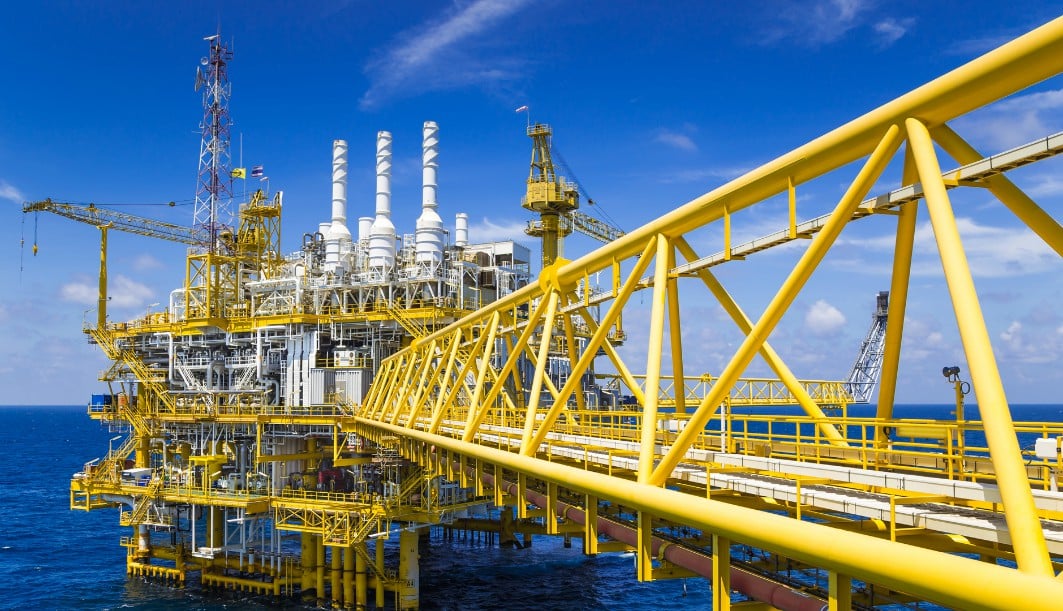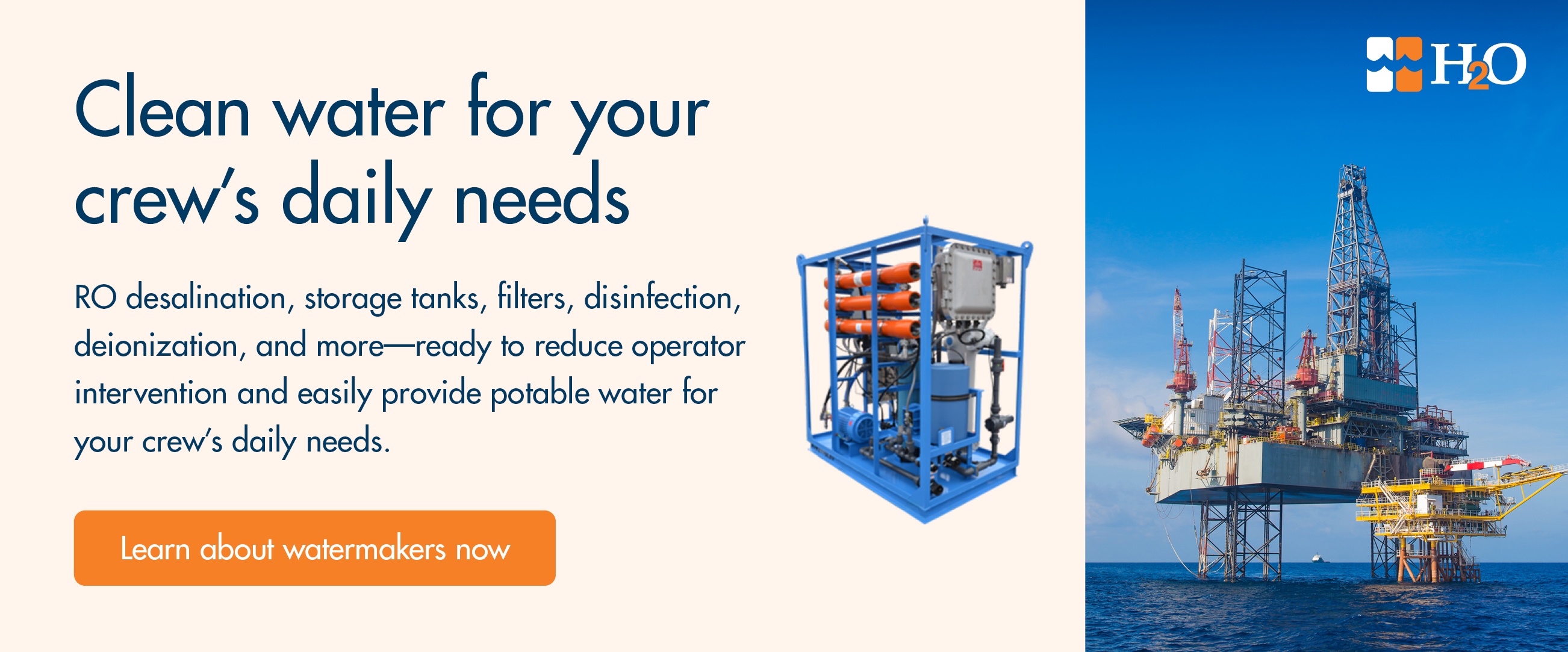
If you work on or maintain a boat, offshore rig, or offshore oil or gas production platform, you know that one of your most important consumables is fresh, potable water. The saltwater with which you’re surrounded is filled with not only salt but also refuse, seaweed, silt, and other contaminants that can make it unsafe for regular use.
Through the process of reverse osmosis, you can take any kind of water; filter, neutralize, and disinfect it; and get fresh water as an output. A device known as a watermaker harnesses the power of reverse osmosis and uses specialized protocols to make sure that the processed water is safe for drinking—and safe for long-term storage.
A watermaker depends, in part, on a fine-tuned high-pressure pump to drive the integral reverse osmosis process. It’s important to know how your watermaker works, what the unsafe conditions for your high-pressure pump may be, and how to maintain your system to ensure a constant source of safe water.
Why Is a Watermaker Important for the Safety of Your Crew, and How Does a Watermaker Work?
Watermakers are often installed on large offshore drilling rigs or production platforms in the oil and gas industry, as well as on marine vessels. They make it possible for people to spend large amounts of time offshore, without direct access to clean water. Although it might be possible to simply use transported water reserves for small groups of people, larger crews need a constant source of potable water. Some watermakers can support crews of up to 400 individuals.
The seawater will go through a pre-filtration process to take out anything large and floating, including trash, seaweed, larger particles of silt, or dirt. This helps keep more delicate pieces of the desalination unit safe.
Next, the partially cleaned water will be forced through a membrane under high pressure, otherwise known as the process of reverse osmosis. A watermaker can extract 35-40 percent fresh water from an intake feed of seawater. The resulting concentrated brine will be dumped overboard.
The immediate output of the reverse osmosis process is cleaner water, but it’s not yet potable. Instead, this output water is slightly acidic, which can corrode pipes over time. To make this water completely safe for storage, it’s run through a remineralizer tank. Finally, chlorine is added to disinfect the water.
If chlorine isn’t added before the water is stored, the standing water could attract pathogens and become unsafe. Anyone who drinks or interacts with that water could get ill—for example, Legionnaires’ disease is inhaled as opposed to being injested. The disinfection step performed after reverse osmosis helps ensure that the water is safe for immediate use as well as for storage.
However, the reverse osmosis process, through which the saltwater is forced into a membrane by a high-pressure pump, is where it all begins. Membranes used in reverse osmosis are fairly selective. Only water molecules can pass through these membranes, and little else. However, it does take a significant amount of pressure to force the water through—which is why the high-pressure pump on your watermaker is so important.
What Happens If the High-Pressure Pump on Your Watermaker Fails?
Simply put, if the high-pressure pump on your watermaker fails, you won’t have a fresh source of water anymore.
Above, we noted that the driving force behind reverse osmosis comes from your system’s high-pressure pump. Reverse osmosis is the process that makes your water clean. If the high-pressure pump fails and cannot compensate for the natural osmosis process, your watermaker will not produce fresh water. In an offshore situation, you could effectively be stranded on an island surrounded by saltwater, with no further source of potable water.
If you’re on an offshore rig or production platform when your watermaker goes down, you might have to revert to emergency protocols to conserve water until you can retrieve specialists and repair parts. If your water reserves get too low, you might have to pay for emergency water reserves to be transported by boat.
This water will likely be lower-quality water, from a ground well and likely not chlorinated. It can be a life-saving option in a worst-case scenario, but your first plan should always be to take care of your watermaker so you aren’t caught off guard by an unexpected shutdown. This will include taking care of all of the component parts of your watermaker, including your high-pressure pump.
How to Maintain the High-Pressure Pump on Your Watermaker
Maintaining the high-pressure pump on your watermaker comes down to two crucial things: protecting your pump so nothing gets into it and running your watermaker frequently so the entire system is always well-lubricated and ready to go.
Protect your high-pressure pump from wear and tear.
Because your high-pressure pump is an integral part requiring specific environmental conditions, you need to keep it safe from any contaminants or undue force. Here are a few tips that can help you accomplish this goal:
- 1) When installing a new high-pressure pump, remember that there must be a gap in the coupler of approximately three millimeters. This prevents any load from transferring to the motor shaft and wearing the pump down. If the new pump is instead installed flush against the coupler, you could trash the pump in 24-48 hours because end play in the motor shaft will push against the pump shaft.
-
2) Your system’s high-pressure pump requires a 10-micron absolute filter—a very fine filter and the absolute rating means that it’s efficient to 99.98% across the entire filter.. A nominal micron rating (typical cartridge filter) is only efficient up to 90% , with thousands of gallons of seawater flowing through the system daily, this can add up to a large volume of particles that are not being filtered out properly.The system contains water-lubricated pumps that have tight tolerances. You don’t want to get anything too large into the pump. Remember that large is a relative term: A 10-micron particle is too small to be seen with the naked eye, but it could cause major issues for your pump.
-
3) Make sure that the watermaker isn’t being overloaded. The feed pressure going to the high pressure pump is critical. Anything outside a safe window of 29 psi to 72 psi should be corrected or the watermaker should be brought offline until parts arrive to resolve this.. Anything below 29 psi will cause a process called cavitation, which will ultimately cause wear on your system. Anything above 72 psi will cause wear on your pistons. Staying within that safe window will help you avoid systemic wear.
Aim to run your watermaker at least 50 percent of the time—continuously, if possible.
Your watermaker is made to run continuously—24/7/365. Even if you have a small crew and don’t actually need that much potable water, it’s still a good idea to run the watermaker as much as you can: at least once a day, or 50 percent of the time. Stopping it overnight is fine, but running it as infrequently as once a week may result in issues.
If the watermaker sits inactive any longer than that, you’ll start to have issues with its status and performance. The membranes, for example, will grow bacteria if they’re left in standing water. If the housings around the filters are not drained, they’ll start to grow bacteria as well. After those bacteria die, you’ll likely notice a stagnant, stale aroma in that area of your system.
When saltwater sits in the pump, as the water evaporates, the salt will crystallize within the pump. Then, when you turn your watermaker back on and the high-pressure pump fires into action, the newly formed salt crystals will grit on the pump, causing wear and tear.
One metric to keep an eye on is feed water, or high pressure pump, flow rate, in gallons per minute. The high-pressure pump on your watermaker is a positive displacement pump. This means that it’s built to maintain a specific flow rate, as long as it’s in good condition. As a result, if you notice that the feed flow is going down, that’s a good indicator that the pump is going to require inspection. That target flow rate is based on the watermaker’s size and the specific high-pressure pump used.
Maintaining Your High-Pressure Pump Can Ensure a Constant Supply of Safe Water for Your Crew
Taking care of your high-pressure pump comes down to making sure that it’s not overworked, it’s not corroded or scratched with foreign particles, and the entire watermaker is running smoothly. Running your watermaker every day will go a long way toward making this happen.
If your watermaker seems to be in need of service, it’s always a good idea to call in professionals because the stakes—clean water for your crew—are high. At H2O LLC, we supply various industries with their water treatment needs. More than that, however, we’re happy to provide expert repair services when needed. Reach out to H2O. for top-tier watermakers, maintenance, and support.

